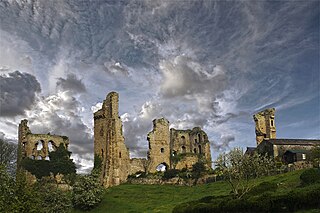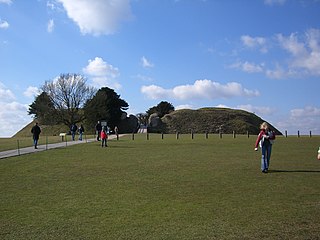
William Longespée, 3rd Earl of Salisbury was an Anglo-Norman nobleman, primarily remembered for his command of the English forces at the Battle of Damme and for remaining loyal to his half-brother, King John. His nickname "Longespée" is generally taken as a reference to his great physical height and the oversize weapons that he used.

William de Longchamp was a medieval Lord Chancellor, Chief Justiciar, and Bishop of Ely in England. Born to a humble family in Normandy, he owed his advancement to royal favour. Although contemporary writers accused Longchamp's father of being the son of a peasant, he held land as a knight. Longchamp first served Henry II's illegitimate son Geoffrey, but quickly transferred to the service of Richard I, Henry's heir. When Richard became king in 1189, Longchamp paid £3,000 for the office of Chancellor, and was soon named to the see, or bishopric, of Ely and appointed legate by the pope.

Sir Robert de Ros was an Anglo-Norman feudal baron, soldier and administrator who was one of the twenty-five barons appointed under clause 61 of the 1215 Magna Carta agreement to monitor its observance by King John of England.

Ranulf de Blondeville, 6th Earl of Chester and 1st Earl of Lincoln, known in some references as the 4th Earl of Chester, was one of the "old school" of Anglo-Norman barons whose loyalty to the Angevin dynasty was consistent but contingent on the receipt of lucrative favours. He has been described as "almost the last relic of the great feudal aristocracy of the Conquest".

Sheriff Hutton Castle is a ruined quadrangular castle in the village of Sheriff Hutton, North Yorkshire, England. The site of the castle is 10 miles (16 km) north of York, and 8 miles (13 km) south-east of Easingwold.

Nicola de la Haie, of Swaton in Lincolnshire, was an English landowner and administrator who inherited from her father not only lands in both England and Normandy but also the post of hereditary constable of Lincoln Castle. On her own, she twice defended the castle against prolonged sieges. After the death of her second husband in 1214, she continued to hold the castle until she retired on grounds of old age in 1226.
Sir Thomas Moulton was an English landowner, knight, admiral and judge during the reigns of King John and King Henry III. From a family with landholdings in the south of Lincolnshire, he was the son and heir of Thomas Moulton and his wife Eleanor Boston. After initial military service, he became a senior judge and held important government positions, in the process extending his inherited estates and accumulating considerable wealth.
Walter of Pattishall was an English justice and administrator. He was the eldest son of Simon of Pattishall, Chief Justice of the Common Pleas, and elder brother of Hugh of Pattishall, Bishop of Coventry and Lichfield. He inherited lands in Northamptonshire, Buckinghamshire, Lincolnshire, Yorkshire and elsewhere, and as a result of his marriage to Margery, daughter of Richard d'Argentan, he acquired lands in Bedfordshire. He followed his fathers footsteps and became a justice, although with less success. His first appointment is as an itinerant justice in the South Midlands between 1218 and 1219, followed by occasional service as a royal justice, sitting for the last time in June 1231.
Sir Thomas Canville, also written de Camville, was an Anglo-Norman landowner and judge in medieval England.
Eustace fitz John, Constable of Chester, was a powerful magnate in northern England during the reigns of Henry I, Stephen and Henry II. From a relatively humble background in South East England, Eustace made his career serving Henry I, and was elevated by the king through marriage and office into one of the most important figures in the north of England. Eustace acquired a great deal of property in the region, controlled Bamburgh Castle, and served jointly with Walter Espec as justiciar of the North.

Hugh Bardulf or Hugh Bardolf was a medieval English administrator and royal justice. Known for his legal expertise, he also served as a financial administrator. He served three kings of England before his death.

John de Lacy, 2nd Earl of Lincoln was hereditary Constable of Chester, 7th Baron of Pontefract, 8th Baron of Halton and 8th Lord of Bowland.

Hugh de Neville was the Chief Forester under the kings Richard I, John and Henry III of England; he was the sheriff for a number of counties. Related to a number of other royal officials as well as a bishop, Neville was a member of Prince Richard's household. After Richard became king in 1189, Neville continued in his service and accompanied him on the Third Crusade. Neville remained in the royal service following Richard's death in 1199 and the accession of King John to the throne, becoming one of the new king's favourites and often gambling with him. He was named in Magna Carta as one of John's principal advisers, and considered by a medieval chronicler to be one of King John's "evil counsellors". He deserted John after the French invasion of England in 1216 but returned to pledge his loyalty to John's son Henry III after the latter's accession to the throne later that year. Neville's royal service continued until his death in 1234, though by then he was a less significant figure than he had been at the height of his powers.
Robert Waterton was a trusted servant of the House of Lancaster under three monarchs, Henry IV, Henry V, and Henry VI. As Constable of Pontefract Castle, he had custody of Richard II after that king was deposed.
Sir Hugh Waterton, was a trusted servant of the House of Lancaster.
Robert fitzRoger was an Anglo-Norman nobleman and Sheriff of Norfolk and Suffolk and Northumberland. He was a son of Roger fitzRichard and Adelisa de Vere. FitzRoger owed some of his early offices to William Longchamp, but continued in royal service even after the fall of Longchamp. His marriage to an heiress brought him more lands, which were extensive enough for him to be ranked as a baron. FitzRoger founded Langley Abbey in Norfolk in 1195.
Philip of Oldcoates was an English nobleman and royal official.

The Constable of Chester was a mediaeval hereditary office held by the Barons of Halton. The functions of the Constable are unclear, possibly they related to the custody of Chester Castle, as was the main function of most mediaeval constables, but Sanders (1960) says the office-holder was constable for the entire County Palatine.

The Domesday Book of 1086 AD lists King William the Conqueror's tenants-in-chief in Snotinghscire (Nottinghamshire), following the Norman Conquest of England:
William de Stuteville Baron of Cottingham in the East Riding of Yorkshire, Lord of Buttercrambe in the North Riding of Yorkshire, was an English noble.












